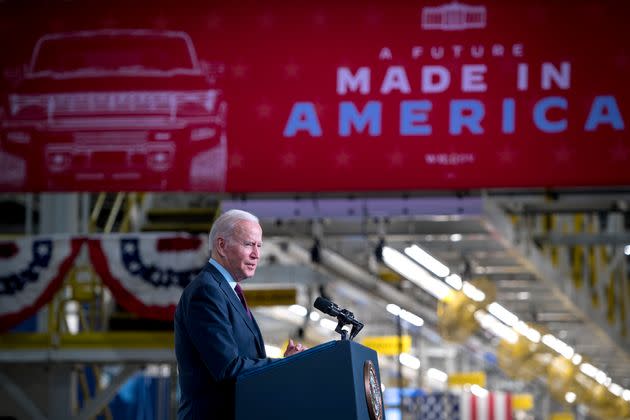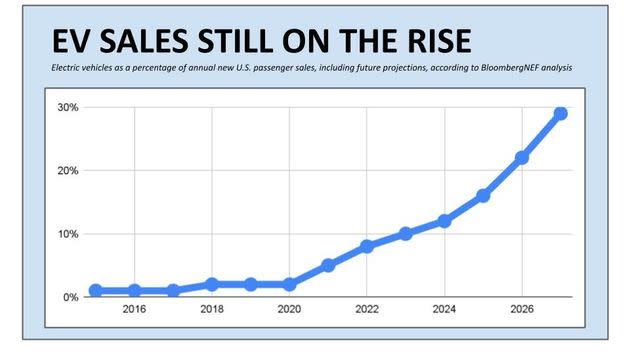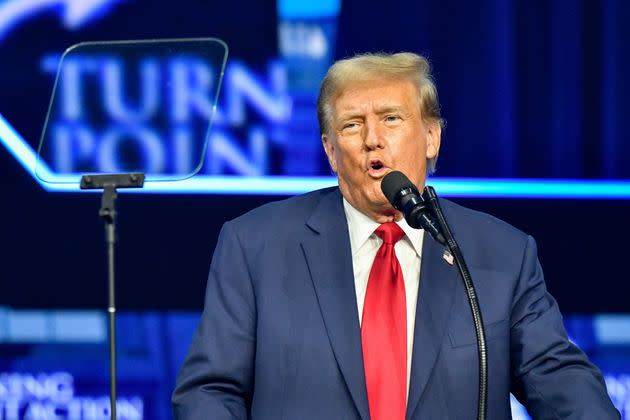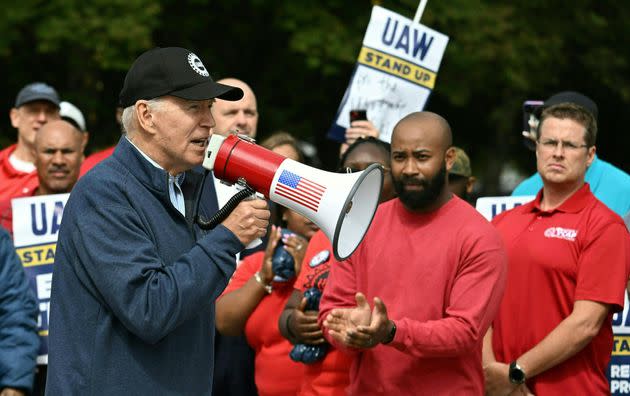What Trump And Biden Really Mean When They Fight About Electric Vehicles
President Joe Biden sketched out his vision for the future of America’s auto industry during a visit to Detroit in late 2021. And he couldn’t have picked a more appropriate spot to do it.
He spoke on the assembly floor of “Factory Zero,” a plant that General Motors had just retooled in order to produce electric vehicles (EVs) and their batteries. Factory Zero sits on the site of an old Chrysler plant that during World War II supplied the “Arsenal of Democracy.” Now, Biden said, he wanted to enlist the auto industry in a different kind of war ― a war against climate change ― while providing reliable middle-class jobs and restoring some of the industry’s lost global stature.
“I want you to feel the way I feel: pride in what we can do when we’re together as the United States of America,” Biden said. “And it starts here in Detroit.”
Many of Biden’s predecessors made similar vows. Few (maybe none?) followed up with such a flurry of regulatory action or by signing anything as ambitious as the 2022 Inflation Reduction Act (IRA). Today that law is pouring tens of billions of dollars into EV subsidies, just like Biden promised, as part of what is arguably the single biggest bet on industrial policy in recent American history.
The effect is not hard to spot. Facilities such as Factory Zero are under construction or in operation across the industrial Midwest and a new “battery belt” in the South. The United Auto Workers (UAW) has won the right to organize in many of these plants and just a few weeks ago secured a new contract at an Ohio facility that should help set new standards nationwide. EV sales continue to go up.
But sales aren’t increasing as quickly as analysts or the industry predicted. The UAW is still struggling to organize outside of the Big Three (General Motors, Ford and Stellantis), whether it’s at domestic challengers, such as Tesla, or foreign-owned “transplants,” including Hyundai. And for all the talk of American automakers recapturing their global swagger, it’s China that has leapfrogged the rest of the world to become the leader in EV production. Last month, Biden enacted a series of high tariffs on Chinese EVs to block them from the U.S. market.
The possibility of China capturing U.S. sales has gotten a lot of attention from former President Donald Trump, who mentions it constantly on the campaign trail, though in Trump’s view, the problem isn’t just what’s happening in Beijing. It’s also what’s happening in Detroit, which, to be clear, he blames on Washington.

Trump has attacked Biden’s EV push as a boondoggle that is forcing American companies to manufacture unprofitable, undesirable vehicles. He hasn’t spelled out exactly what chain of events he envisions as a result — this is Trump, after all — but in his speeches and interviews, he has said it will be a “bloodbath” for American workers. Trump has pledged to reverse Biden’s policies, if elected, while taking even more aggressive action to stop imports.
The debate over EVs hasn’t gotten much attention in the national media. In an election offering such stark contrasts of presidential temperament, and such fraught possibilities for American democracy, arguments about corporate subsidies, trade barriers and carbon emissions don’t exactly light up social media. But this debate’s outcome could have a big effect on the American economy and middle class, not to mention the planet.
The electoral stakes are high, too, and not just because so many of those manufacturing jobs are in Midwest swing states. With Trump’s appeals to red-blooded Americans who want big gas-burning trucks and Biden’s pitch to the hard-hat crowd, the EV debate has become yet another proxy fight in the nation’s culture wars — and a test of who really cares about the working class.
How Biden Is Trying To Promote EVs
An easy way to think about Biden’s EV push is as a series of negative and positive financial incentives.
The negative incentives include new regulations that, taken together, penalize automakers if they produce too many gas-guzzling cars and trucks. The positive incentives come from those EV subsidies in the Inflation Reduction Act, some of which go to the manufacturers and others that go to consumers. The benefit for buyers is available at the point of sale, so that it functions as discounts on the sticker price, as much as $7,500 per vehicle.
The economic logic of this approach is that it closes the price gap between gas and electric vehicles, thus capturing the invisible cost of pollution. But ― and this is key ― the subsidies don’t simply underwrite green transportation. They underwrite green transportation produced here. Only vehicles and parts made primarily in North America qualify.
Not so long ago, that would have been more controversial, with economists in both parties wary of having the government tamper so directly in markets. But the auto industry has gotten help before, most recently in 2009, during the financial crisis, when the Obama administration rescued GM and Chrysler from liquidation in order to save a key piece of America’s manufacturing base and spare the Midwest more dire economic conditions.
Biden’s team has those same considerations in mind. They also talk more openly ― and enthusiastically ― about the need to level the playing field internationally, given how much support automakers in other countries get from their governments. That was true in the late 20th century, when Asian and European competitors benefited from government assistance. And it’s been true in the early 21st century, though now the bigger international threat comes from China.
The story of how China came to dominate world EV production is actually a pretty good case study in how a government can grow an industry with enough determination and patience. Beijing first identified electrification as a goal back in 2001, then spent the next decade pursuing that goal through direct subsidies, favorable bank loans and mass purchasing by municipal governments.

Today, Chinese firms lead the world in vehicle and battery production ― and, many analysts feel, in technology as well. The showpiece Chinese vehicle, from a company called BYD, is a sedan that would probably list for about $20,000 in the U.S. It’s already selling well in Europe, where officials recently raised tariffs in order to stop the Chinese imports from getting even more market share. Biden’s new Chinese EV tariffs are designed to stop them from getting a foothold here.
The hope is that these trade barriers, along with the emission standards and subsidies, buy American companies enough time to develop the kind of manufacturing and design expertise that would enable them to compete with foreign competitors. Ilaria Mazzocco, a senior fellow at the Center for International and Strategic Studies, has studied China’s EV industry as closely as anybody in the U.S. She sees many parallels between what Chinese officials did in the past and what the Biden administration is trying to do now.
“The IRA probably took some inspiration from the Chinese playbook in some ways,” she told HuffPost.
But, Mazzocco noted, the playbook is easier to run in an authoritarian country. “The big advantage that China has when it comes to things like industrial policy is that it has a policy stability,” Mazzocco said. “If Xi Jinping decides he wants to back something, you can be sure that it’s going to stay the same for a certain amount of time.”
No such guarantees exist in the U.S., where political opposition matters, and, at the moment, could be months away from taking power.
What Trump Is Saying About Biden’s EV Push
Trump has made plain his opposition to Biden’s EV support, in speeches and in interviews ― and in the “Agenda 47” section of his campaign website, where a page dedicated to the auto industry pledges to roll back Biden’s new emission standards and “stop the flow of American tax dollars that are subsidizing Chinese electric vehicle battery companies through Joe Biden’s so-called Inflation Reduction Act.”
Trump hasn’t offered more detail about his plans or his thinking, except to say he’d also block Chinese imports. And a campaign spokesperson declined to answer queries from HuffPost. But some conservative economists have fleshed out the arguments for why, in their view, Biden’s EV agenda is bad for America.
One of them is Diana Furchtgott-Roth, who served in every Republican administration since Ronald Reagan’s and now leads the Heritage Foundation’s Center for Energy, Climate, and Environment. Furchtgott-Roth has a record of skepticism toward climate change predictions and environmental initiatives. But the thrust of her case against Biden’s policy is that it’s foolish ― and ultimately destructive ― for the government to put its thumb on the scale of a product that many Americans may not want.

“Electric vehicles are great for some people, especially for people who have garages and can charge them overnight, and people who don’t have to drive very far during the day,” Furchtgott-Roth told HuffPost. “But if you take, say, a handyman who lives on his pickup truck and doesn’t have a garage where he can charge his truck, then it very much increases his costs by requiring him to have, say, a Ford Lightning instead of a Ford F-150. It’s a more expensive vehicle. He can’t charge it in this home. And he can’t stop for one or two hours out of the day to charge it up, because that impedes with his business.”
Strictly speaking, nothing Biden has done would prohibit Ford from continuing to manufacture F-150s or prevent those handymen from buying them. But the whole point of his agenda is to change the financial equation so that it’s a lot more favorable to electric alternatives, and that’s precisely the problem from Furchtgott-Roth’s perspective.
Push the manufacturers to hit hard EV targets, she warned, and American manufacturers will end up with vehicles they can’t sell ― a recipe for losses and eventually a dramatic downsizing of American industry. If that happens, she said, foreign competitors are likely to fill the void, and that includes Chinese companies like BYD.
“I think it’s a forced march towards EVs; it’s not a natural progression,” Furchtgott-Roth said. “We’re better off letting the market sort itself out.”
What Industry Analysts Are Saying About EVs
EV skeptics can point to a number of recent developments to bolster their case, starting with first-quarter 2024 sales that came in below projections. Tesla has been cutting prices to reduce big inventories while Ford last year scaled plans for a massive, highly touted battery factory under construction in Michigan.
Even EV enthusiasts acknowledge that the market is in a new, more difficult phase, when manufacturers have to reach mainstream consumers still anxious about range and the availability of commercial charging.
The risk of inaction is much higher than it used to be. The transition is going to happen.Corey Cantor, BloombergNEF
But EV sales are still rising, in absolute terms and relative to other kinds of vehicles, and in just the last few weeks, Bank of America, Bloomberg NEF and Cox Automotive issued annual reports projecting EVs would keep gaining market share. “We have EV share of sale[s] growing to 29% by 2027, so that’s about one in three vehicles,” Corey Cantor, a senior auto industry analyst at BloombergNEF, told HuffPost. “That’s pretty good,”
Cantor said he and other analysts feel confident about EV growth because the vehicles have a lot going for them, including not just freedom from high gas bills but also, in many cases, “a better ride experience.” EVs are already on their way to taking over markets overseas, Cantor noted, and the products will only get better as companies innovate ― although, he cautioned, it’s an open question how big a part American firms in general play in that process, especially if they lose government support.
“The risk of inaction is much higher than it used to be,” said Cantor. “The transition is going to happen. And I think, if anything, that makes it much harder for the U.S. to not have those policies in place.”
The possibility of falling further behind Chinese and other competitors is precisely why former Biden advisers like MIT Innovation Fellow Brian Deese say it’s Trump’s promise to yank federal EV support that represents the greatest threat to American companies and, ultimately, American workers.
Deese, who knows a thing or two about the industry after managing the Obama administration’s rescue, told HuffPost that “the economic logic to invest in those things globally is only going to increase, but the economics of making those investments in the United States would be ripped out” if Trump were to reverse Biden’s policies.
How The Future Might Unfold
Even with government help, the transformation will be difficult for the Big Three and their suppliers ― who, politically, are the ones both Biden and Trump are trying so hard to court.
Nowadays the companies focus on relatively expensive trucks and SUVs, the vehicles that generate the biggest profits, and even their EV offerings have focused on the high-end market. GM is about to roll out a line of lower-priced EV products, including a revival of its discontinued (but popular) Bolt. It’s an open question how well that will go, and whether Ford and Stellantis (the conglomerate that owns Chrysler) can make inroads of their own.
Other challenges await. Qualifying for the maximum EV tax credits will eventually require relying more on batteries produced domestically. But right now U.S. companies don’t have either the raw materials or know-how to do that. Those new UAW agreements will raise worker pay, but that will also add to EV costs at a time when the companies are learning how to make the vehicles profitably.
I think it's a forced march towards EVs; it's not a natural progression.Diana Furchtgott-Roth, Heritage Foundation
And then there’s the complexity of dealing with China.
In both the Biden and Trump camps, advisers and supporters say the U.S. can’t rely too heavily on a potential adversary for vehicles or for production know-how. They also say it’s important to prevent espionage and data stealing, which could become easier if Chinese companies and vehicles gain a big U.S. presence.
But the Chinese have gotten so far ahead in EV technology that the only way to catch up may be to copy and learn from them. And that may only be possible through joint ventures. This was a big part of how the Big Three caught up to Asian and European competitors the last time they fell behind, during the 1970s, ’80s and ’90s, when they were slow to meet demand for smaller, more fuel-efficient cars.
Memories of that era are also among the reasons why former Biden officials like Sonia Aggarwal, who was special assistant to the president for climate policy, think it’s so important for government to boost U.S. firms today.
“I would say we tried in this country to ignore where the world was going in the auto industry before,” Aggarwal, who is now chief executive officer of the think tank Energy Innovation, told HuffPost. “It didn’t work out very well for us when we did that.”
Why Judgment, Values Matter As Much As Agenda
Biden’s EV push will require constant adjustment based on changing circumstances, as any such enterprise would. The same goes for Trump’s preferred alternative. Pulling back on EVs may sound like a simple matter of taking away Biden’s regulations and subsidies, but every one of those moves would require countless decisions about details ― and constant attention to how changes were playing out in the real world.
All of that suggests a president’s temperament, judgment and priorities matter as much as their policies. And here the differences between Biden and Trump are even starker.
Trump has tried to turn EVs into a symbol of cultural liberalism ― of weakness or wokeness, or both ― while portraying himself as a champion of working-class Americans. But Trump’s record shows he’s better at making promises to autoworkers and their families than delivering on them. While he was president, he vowed to save a storied GM factory in Lordstown, Ohio. The plant closed anyway. He talked about championing American workers, then filled agencies like the National Labor Relations Board with anti-union appointees.
These developments happened against the backdrop of a Trump governing agenda that shifted money away from lower- and middle-income Americans and toward the rich ― most obviously through the 2017 Republican tax cut that Trump promoted and signed into law. Another Trump term could mean more of the same.
The centerpiece of Trump’s 2024 economic agenda is an across-the-board tariff that he has suggested would replace the income tax.In addition to creating massive new deficits, such a change would function like another big tax cut for the wealthy, since they spend less of their money on goods that the tariffs would affect.

It’s not even clear the tariffs would help the auto industry or its workers, who Trump says would be the primary beneficiaries. Unlike Biden’s new tariffs, which target just one country and one set of products, Trump’s would apply to all imports, including those from friendly trading partners, and not just to vehicles but to the parts that go into vehicles. That could make all cars and trucks in the U.S. a lot more expensive while wreaking havoc with supply chains based on long-established, carefully negotiated purchases of materials from abroad.
Biden’s governing record suggests a very different set of priorities, whether it’s his broad economic agenda of raising taxes on corporations and the wealthy while providing more assistance to the poor and middle class or, more specifically, what he’s done for the auto industry and its workers.
Probably the best example is how he conducted himself last fall, when the UAW was on strike. Privately, he pressed the Big Three to give labor a better deal. Publicly he joined striking workers on the picket line ― something, according to historians, no president had done before.
The problems facing America’s automakers, like the problems facing the planet, are difficult to solve. No president is going to make all the right calls. But some have records showing they genuinely care about the industry and its workers. Some don’t.
How voters assess those records could determine who wins in November. As Biden said in 2021, it all starts in Detroit.

